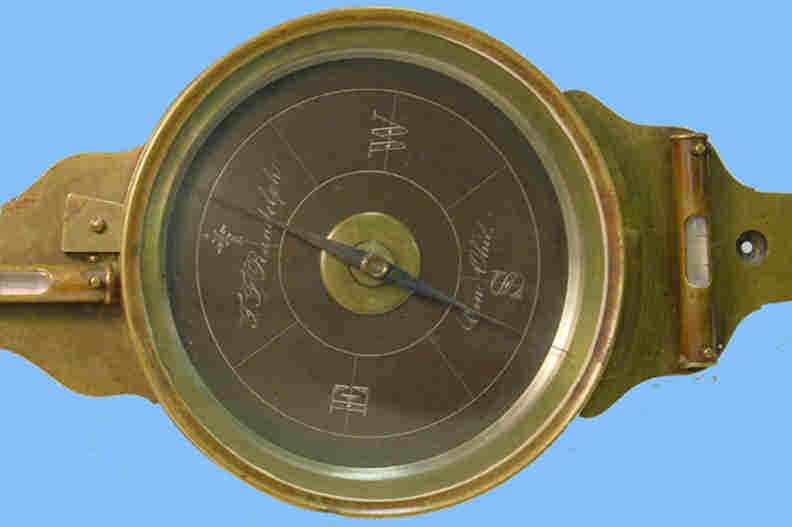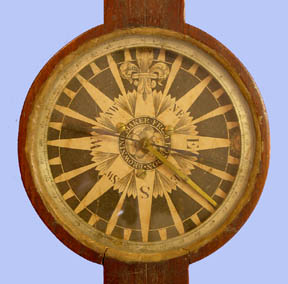COMPASSES
CM 1, Surveyor's Plain Compass, Thomas Greenough,
maker, Boston, New England, c. 1760.
 |
This compass is possibly made of cherry wood. It is
12.2" long, has 4" high sights and a 4.2" long needle. The paper
compass card shows a man in a red coat looking out to sea with a quadrant
instrument, and a sailing vessel on the horizon. The card has printed divisions
of 0° to 90° in each of the four quadrants. There is some damage to the
divisions in the vicinity of S 15° W, considering that W is on the E side of
the card as customary. The paper compass card was possibly printed by Paul
Revere. With the compass is a contemporary hand-carved 54" hickory tripod.
The inscription on the compass card reads "Made by
Thomas Greenough, Boston, New England." Compasses by Thomas Greenough are
pictured and described in Silvio Bedini's Early American Scientific
Instruments and Their Makers, 1964, at pps. 85-93.
|
Take a 360 degree look at this instrument by clicking on the
pictures below (requires
Free
QuickTime Plug-In):

CM 2, Surveyor's Plain Compass, [David?]
Rittenhouse, maker, Philadelphia, PA, c. 1770.

|
Probably made by David Rittenhouse rather than by his
brother, Benjamin (see RITTENHOUSE, 5:1, Nov. 1990, pps. 1-16, w/picture
pp. 8). This compass has an automatic needle lifter, and is believed to be the
first instrument with such a device. David Rittenhouse was a leading American
scientist of the revolutionary war period. He was very inventive and not
inclined to decorate all of the compasses he made. All known compasses by
Benjamin are highly decorated (see Bedini: THINKERS AND TINKERS, pp.
211).
This instrument is inscribed "RITTENHOUSE,
PHILADELPHIA." It has a simple compass dial absent of decoration. Three
other compasses are identified only with the Rittenhouse family name. One
belonged to George Washington and is now in the National Museum of American
History. Another privately owned one is highly decorated in the style of
Benjamin Rittenhouse, who is known to have worked for David.
This
Rittenhouse compass is 14.2" long, has removable sights
6.3" high, a 5.5" needle, brass cover to compass box, and a contoured
wood case.
|
Take a 360 degree look at this instrument by clicking on the
pictures below (requires
Free
QuickTime Plug-In):

CM 5, Surveyor's Vernier Compass, Thomas Whitney,
maker, Philadelphia, PA, c. 1800.
|

|
This is one of the earliest known compasses by Whitney. It
has no serial number and is of noticeably different construction than the do
have serial numbers. It is reportedly identical in some of the parts to
compasses by Thomas Biggs. Biggs was an instrument maker of the 1880's and
1890's with a shop in 1892 on the same street as Whitney. The instrument is
14" long, has 6" high sights, and a 5.2" needle. There is but one
spirit level located on the south arm, and it has a sliding brass cover for
protection. The instrument is inscribed "Thos. Whitney, Maker,
Philadelphia." The vernier is located on the north sighting arm, and is
divided from -25° to +25°, but due to limitations in its internal mechanism
can only be used from -10° to +10°. There is a wooden case with the penciled
name "John J. Harris, Redding, California." The letters "J.J.
Harris" are also lightly but crudely scratched into the top of the south
arm of the compass. The ball & socket unit for adapting to a tripod or staff
are missing.
|
CM 6, Surveyor's Plain Compass, H.M. Pool, maker,
Easton, Mass., c. 1850.

|
This instrument is 15" long, has sights 7.4" high,
and a 5.1" needle. There is a brass cover for the compass box, all fitting
into the original wood case. The original ball & socket unit for attaching
to a tripod or staff is missing. There are two spirit levels on the south arm
located next to one another, and at right angles to each other. The case has a
1" sticker indicating the sale price w/o tripod 9/50 is $36.00. Underneath
is an earlier sticker indicating the previous asked price was $35.00. |
CM 7, Surveyor's Vernier Compass, T.F. Randolph,
maker, Cincinnati, Ohio, c. 1867.

|
This compass is 15.8" long, has sights 7.9" high,
and a 6" magnetic needle. The compass dial is black. The vernier is located
on the south arm outside the compass box. There are two spirit levels, one on
each arm, both with clear glass and black lines. An open tapered hole in the
south arm suggests a possible missing part, which is not the case. An
illustration of this exact instrument appears on pp. 26 of the 1889 edition of
Thomas Bagot's A Manual of Plane Surveying. This print shows the same
open tapered hole as the present instrument. |
Take a 360 degree look at this instrument by clicking on the
pictures below (requires
Free
QuickTime Plug-In):

CM 27, Surveyor's Plain Compass, [Samuel] Browning,
maker, Boston, c. 1816.
 |
This plain surveyor's compass has brass sighting vanes and
compass ring on a mahogany base. The overall length is 15", the compass box
is 6 3/4" diameter, the needle 5" long, and the sights are 4 3/4"
high. The paper compass card at the north end is imprinted Browning, Boston
and at the center is marked Browning Maker from London. An identical
instrument is in the Henry Ford Museum in Dearborn, Michigan and described in
Charles Smart's book. Samuel Browning is listed in Boston directories from 1803
to 1841 and from 1816-1825 as a mathematical instrument maker.
|
Take a 360 degree look at this instrument by clicking on the
pictures below (requires
Free
QuickTime Plug-In):

Go To Next Page Of
Compasses
Go To Unique Gurley
Mountain & Mining Compass





